Best Scottish Shortbread Recipe
A traditional Scottish shortbread recipe makes the most mouth-wateringly delicious buttery cookie.
But over the centuries the ingredients used have changed quite a bit - and if a 12th century Scot was to get a taste of modern-day shortbread, he might get quite a surprise!
Today's recipes use butter, sugar and flour to produce that exquisite, melt-in-your-mouth texture and flavor that is so addictive, but the very first shortbread was entirely different.
I'm originally from the UK, so I love my biscuits, and here in the USA I also love my cookies, but I've never considered shortbread to be either, because to me, it's in a class of it's own.
No 'butter cookie' or loosely-termed 'shortbread' can come close to the delicious, richness of real Scottish shortbread!
I've featured two recipes on this page, with slightly different ingredients. They'll both give you the traditional flavor and texture of the best Scottish shortbread.
Pick one, or try them both, whichever you do you won't be disappointed!
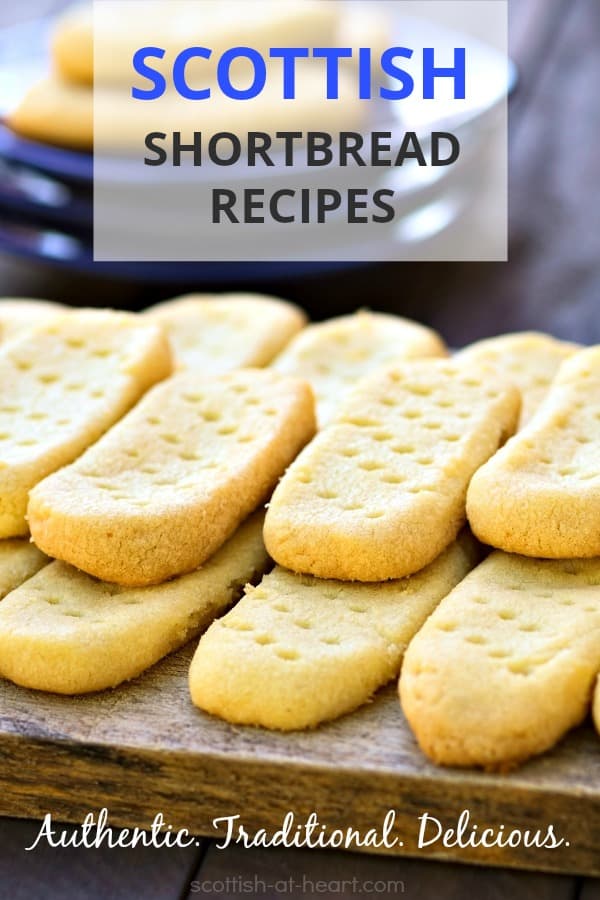
History of Scottish Shortbread
The very earliest Scottish shortbread was made from remnants of left-over bread dough which contained oatmeal and yeast (hence the 'bread' part in the name), which was then sprinkled with sugar and baked slowly in a cool oven.
The 'short' in the name comes from the baking term 'short' which indicates a crumbly texture.
I can remember my Nana making two different types of pastry, one she called 'shortcrust' pastry because it was flakier and more crumbly than the other one. She always used it for sweet pies, and the 'regular' pastry was for meat or savory pies.
This produced a very hard, dry biscuit-bread. A handy, easily-portable snack which didn't spoil quickly.
But try putting a piece of today's shortbread in your pocket and see what happens - it's an entirely different animal!
Fun Fact: Porridge started off in a similar way, as a 'take out' snack. Check out this page to see learn exactly how that worked!
In addition to the basic ingredients used to make the 'short bread' of the time, extra ingredients were often added. My guess would be that this was to make it taste better as it was likely fairly plain to begin with.
Popular additions were coriander, caraway seeds, almonds, citrus peel, dried fruit.
Mary Queen of Scots was known to enjoy shortbread in the 16th century.
Apparently she enjoyed sweets, and had a taste for French food (honestly, with the exception of shortbread, and maybe Empire Biscuits, you can't beat French pastries and sweet stuff!), which may have partly contributed to the change in ingredients and flavor.
Legend also has it that in the 18th century, Bonnie Prince Charlie was also a fan.
There's no written evidence of exactly when the sweeter, 'fancier' version of shortbread, the one featuring butter and sugar, began to appear. But it is known that by the mid 1800's yeast was no longer being used, and many of the 'added extras' that were traditionally added were also becoming less popular.
Originally the butter-shortbread variety was expensive and most people only got to taste it on special occasions, such weddings, Christmas, Hogmanay (New Year's Eve), Burn's Supper (a celebration in honor of the birth of Scotland's famous poet Robert 'Rabbie' Burns, January 25 each year) and other 'high days and holidays'.
Now, of course, shortbread can be enjoyed anywhere, at any time, and if you don't you don't have the time or ingredients to bake it at home, or you simply don't feel like making your own, there are some good commercial options. Walkers (founded in 1898) shortbread being one of my favorites.
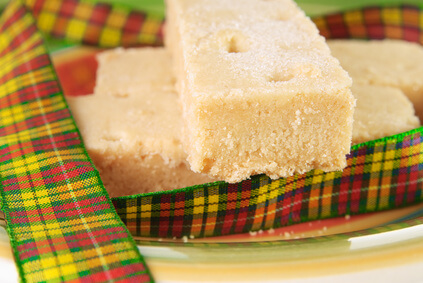
Although there were some very early cookbooks written prior to the 18th century, often for royalty, most Scottish families had recipes which were handed down from mother to daughters (and grand-daughters). Sometimes written, sometimes simply learned and committed to memory.
In the early 1700's that began to change, and the very first printed recipe for Scottish shortbread appeared in a cook book called 'Mrs McLintock's Receipts for Cookery and Pastry-Work' published in 1736.
It doesn't resemble a recipe for modern day shortbread at all, except for using lots of butter.
Here is her recipe:
'Take a peck of Flour, put three lb of Butter in amoung a little water, and let it melt, pout it in amoung your Flour, put in a Mutchkin of good Barm; when it is wrought divide it in three parts, roll out you cakes longer then broad, and gather from the sides with your Finger, cut down the Middle and job it on Top, then send it to the oven.'
You may have trouble deciphering that because the measurements are all really old school Scottish (well, she was writing this in 1736).
Scottish measurements like these changed depending on the century, they also varied regionally, so I can't be absolutely sure (even with extensive research) as to exactly how much a 'peck' or a 'mutchkin' was at this time.
Also, math is not one of my strong suits, so feel free to research and double check the following if you're interested in learning more.
- 1 peck of flour was approximately 20lbs*
- 1 mutchkin was approx. 3/4 pint
- Barm was fermenting ale
1 peck=1.996 imperial dry gallons
1 imperial dry gallon=10lbs
(source: Dictionaries of the Scots Language)
Clearly she was baking shortbread for a lot of people!
About Scottish Shortbread
Shortbread has several rituals and traditions associated with it.
Historically this tasty treat played a part in welcoming new brides in the Shetland and Orkney Isles to their marital homes.... as the bride and groom crossed the threshold a decorated shortbread (called the 'Bride's Bonn) was broken over their heads!
It is also still one of the foods offered to 'first-footers' (those going door to door on Hogmanay to welcome in the New Year).
Shortbread petticoat tails were said to be one of Mary Queen of Scots' favorites, and she is given credit for increasing the popularity of shortbread in the 16th century.
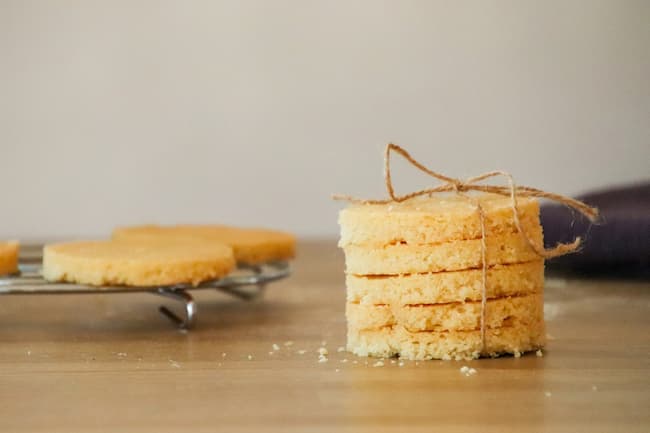
Even the way Scottish shortbread is decorated is symbolic and traditional.
The edges of the circular shortbreads are decorated by pinching with the thumb and forefinger, or making cut-marks with a knife, and it's believed that this is a nod towards the Scots early sun-worshipping days as these pinched edges symbolize the sun's rays.
The center of the shortbread circles, and the length of the shortbread bars are pricked with a fork to complete the decorations.
There are three different 'styles' of Scottish shortbread:
Petticoat Tails
These may have derived their name from the design of petticoats worn under dresses in the 16th and 17th centuries.
The shortbread is pressed into a round tin and then marked out into wedges (like you would a pizza or birthday cake). Each portion is one petticoat tail.
Rounds
Shortbread dough is rolled out and then individual shortbread 'rounds' are created using a round (no surprises there!) cookie cutter. My grandma used to always use the ones with rippled edges, so that's a nostalgic choice for me.
Fingers
Shortbread is rolled out and then marked out into strips, or bars.
Get more details on these shapes here.
Although the classic Scottish shortbread needs no additional flavoring or ingredients to be it's richly delicious self, historically there are some variations, often linked to regions of Scotland.
For example,
Simple Scottish Shortbread Recipe
Ingredients:
- 1 lb (450g) butter (softened)
- 8 oz (225g) castor sugar (superfine sugar)*
- 1 lb (450g) sifted plain flour (all-purpose flour)
- 8 oz (225g) rice flour
- pinch of salt - if using unsalted butter
Directions/Method:
- Set oven to 350F - 190C - Gas Mark 5
- Cover an ungreased baking tray (cookie sheet) with parchment paper
- Mix flour and rice flour, then add salt (if you're using unsalted butter), and sift these dry ingredients at least twice, preferably three times
- Cream butter and sugar together with a wooden spoon (be warned - this takes serious 'elbow grease' but produces a better end result!). Add the sifted ingredients and mix together by hand until you have a soft dough, then form it into a ball.
Now comes a very important step... you need to chill the shortbread dough in the refrigerator for approx. 2 hours.
After your dough is chilled, roll or press out dough on a lightly floured surface until about 1/2 inch thick and use a sharp knife to mark your dough into 3"x1" 'fingers' (or bars) or a cookie cutter to make 'rounds' or shapes. Whichever shape you choose, don't forget to prick the tops with fork tines.
Bake shortbread in preheated oven set at 350F for 10 minutes and then reduce temperature to 325F and continue to bake until shortbread is pale golden. This could be between 45 mins and 1 hour, depending on exactly how thick you've made the shortbread.
Allow your buttery Scottish shortbread to cool in the pan, then transfer to a wire rack to finish cooling completely. Then enjoy!
Shortbread dough needs a light hand!
The shorter the time it takes to mix the ingredients, and the less handling is involved the better. When you minimize both of these you get shorter, crumblier and more delicately textured shortbread.
DON'T be tempted to 'knead' at the dough, as this will make the it 'tough' - and the finished result won't be what you are hoping for.
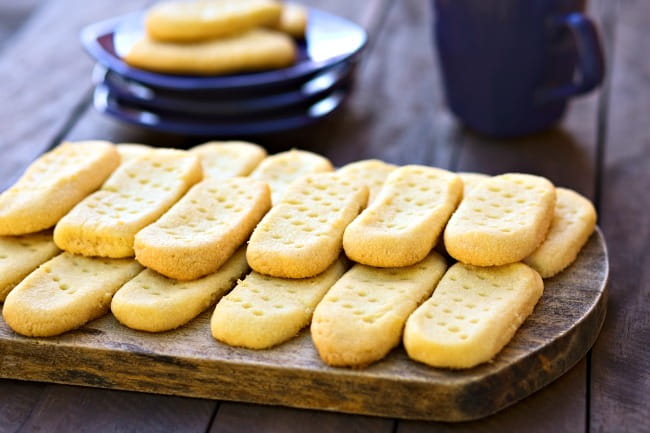
Traditional Scottish Shortbread Recipe
Ingredients:
- 3 oz (85g) icing sugar (confectioner's sugar)
- 3 oz (85g) castor sugar (superfine sugar)
- 10 oz (280g) butter
- 1 lb (450g) plain flour (all purpose flour)
Directions/Method:
Set oven to 280F - 140C - Gas Mark 2
Cream the butter, icing sugar and castor sugar together using a wooden spoon.
Sift the flour 2 or 3 times, then gradually mix into the creamed butter and sugar using your hands, until a firm dough is formed.
Or you can use an electric mixer for the above process as described here.
Now you need to chill the dough in the refrigerator for at least 2 hours before baking.
On a lightly floured surface roll or press dough until about 1/2 inch thick and use a cookie cutter to make 'rounds' or shapes, or slice into 3" x 1" bars and prick the top with a fork.
To make a larger round for 'petticoat tails' follow instructions here.
Bake in pre-heated 280F oven for for approx 30 to 40 mins, shortbread will be a pale golden color when it's ready. Shortbread should not be allowed to go brown.
Making Scottish Shortbread Using an Electric Mixer
I make my traditional Scottish shortbread cookies the traditional way, by hand, because that's the way my Nana taught me to do it.
But if you want to make things a little easier on yourself you can use an electric mixer.
Just beat the butter at medium speed until it's a creamy texture (2-3 mins minimum), then slowly add the sugar and beat for a couple more minutes.
Then combine all purpose flour and rice flour and gradually add this flour mixture to creamed butter and sugar mixture. Beating on low speed between each addition.
If you've used an electric mixer once the ingredients have come together form the dough into a rough ball by hand in the mixing bowl.
Scottish Shortbread Shapes
Make Petticoat Tails by pressing the dough into a circle about 8 - 10 inches across, and about 3/4 inch thick. Carefully transfer dough to baking pan of your choice.
Mark out 16 'slices' with a knife (don't cut all the way through), prick each wedge several times with a fork. Decorate by pinching the outer edges of the dough between thumb and forefinger, and then use a fork to prick the rest of the dough.
To bake your shortbread cookies you can use a regular metal or ceramic pan (line a metal one with baking parchment or a silicone baking mat), a simple ceramic pan, or a pan made specifically for shortbread such as one of the Brown Bag range which have integrated patterns which let you turn out professional looking shortbread cookies quickly and easily.
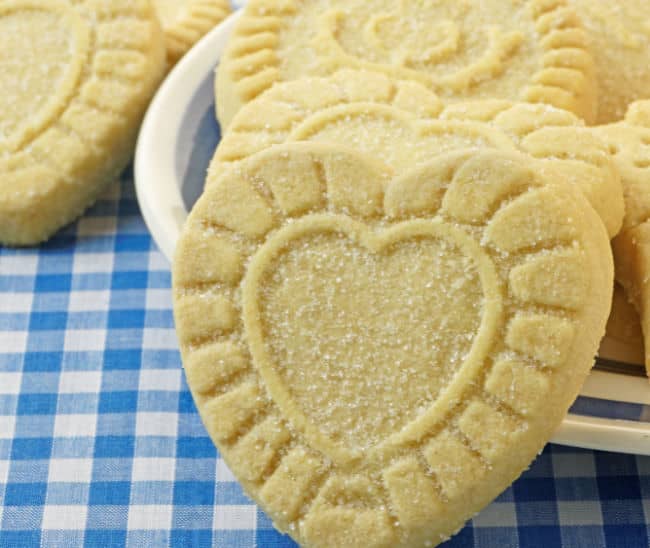
Making Shortbread Fingers:
On a lightly floured surface, press (or use a rolling pin - sparingly!) dough out until it's about 1/2 inch thick, and rectangular in shape and mark into fingers that are approx. 3" x 1" Prick the top with a fork.
Making Shortbread Rounds:
You can use a simple circular cookie cutter, one with rippled edges (very traditional!) or if you don't have either the rim of a smallish glass works great too! If you aim for rounds which are approx. 1 to 1 1/2 inches in diameter that's average.
I love the traditional cutters with rippled edges, my nana always used them. Try a set of four different sized square shortbread cookie cutters, three round ones or a traditional slim 3" rectangle cutter for your shortbread fingers.
Want to get fancy?
If you want to add some pretty embellishments to your cut out shortbread, try a cookie stamp with a traditional symbol such as a Scottish Thistle shortbread cookie stamp.
Using an Scottish thistle embossed rolling pin is an easy way to add a special touch.
Or be different and channel Scotland's National Animal with this 4" unicorn head cookie cutter or with this 3-piece fantasy unicorn set.
Of course you can cut the dough into any shape you want, and holiday shortbread Santas, bells, snowmen etc. are always popular.
Decorative Shortbread Pans
There are several other designs too, including the Brown Bag Rose Window pan, or why not combine your Scottish roots and American pride by using Brown Bag's American Butter Shortbread Cookie pan.
If you prefer a metal tin, the Nordic Ware Snowflake Shortbread pan is another great option, and perfect for making beautiful shortbread to snack on with a hot drink in the winter time.
Tips for Baking Perfect Shortbread:
Butter needs to be softened before you start, room temperature or close to it is best. Resist the temptation to use hot water or a microwave to soften it. When making shortbread cookies you need to plan ahead and allow your butter to soften out of the fridge for several hours, or preferably overnight.
Butter is arguably the most important ingredient in good Scottish shortbread, so choose wisely. Use REAL butter, at the right temperature and you're half way to success.
Pricking the top of the shortbread with the tines of a fork isn't just decorative. The tiny holes help the shortbread to rise and bake evenly, and enhances the traditional crumbly texture.
The color is the best indicator that the shortbread is 'done'. You're aiming for a lovely pale gold all over, if the edges start to look dark then you're in danger of burning them!
Allow shortbread to cool in the pan, then remove to wire cooling rack. When thoroughly cooled these can be stored in an airtight container, cookie tin or any sealed container.
Smaller 'Rounds' or specialty 'holiday' type shortbread cookies need less baking time. Usually somewhere around 20 minutes. Again rely on the color of the shortbread to know when it's done. This can take a little practice, but is well worth the effort!
If you're using a shortbread mold, it's a good idea to dust it with powdered sugar (called 'icing sugar' in the UK) and put it in the fridge for a short while before baking.
Shortbread Cookie Recipe Variations
You can make all sorts of shortbread cookies using a basic Scottish shortbread recipe and then adding a variety of spices, dried fruit, nuts, chocolate etc..... pretty much whatever you fancy, so be creative!
Not feeling too adventurous? Then try one of these variations..... simply pick whichever one you want to try and add it to either of the basic recipes above. It's super easy.
- 3 tbsp grated lemon/orange zest or 1 tsp. lemon/orange extract
- 2 tsp cinnamon, mixed with 1/2 tsp ground ginger and 3/4 tsp allspice
Add half to dry ingredients, then use the other half to sprinkle over shortbread before baking.
You can use one, two or all three spices depending on your own personal preference.
Or try one of these:
- 1 tsp caraway seeds
- 1 tsp almond essence
- 4 tablespoons of finely chopped pecans
- 3 oz cup of dried fruit eg. raisins, sultanas, cherries, dates etc
- 3 oz chocolate chips
Fun facts about Scottish shortbread
January 6 is 'National Shortbread Day'
In the 1980's the EU wanted to classify shortbread as a 'biscuit'. Scottish bakers were vehemently opposed to that idea. They said that shortbread belonged to an ancestral line of 'specialty item of flour confectionary'. They won the argument. (Source: The Oxford Companion to Sugar and Sweets).
We all know that shortbread gets it's richness from the butter, which is the most important ingredient. But did you know that in 1921 the British Government decreed that to be called 'shortbread', a product must get at least 51% of its fat from real butter?
Hooked on Scottish Baked Goodies?
Scottish 'treats' come in all shapes, sizes and flavors. Each and every one of them is delicious!
If you'd like to taste more of the magic, check out these recipe books for a wide variety of some of Scotland's most delicious offerings....
The Hebridean Baker by Coinneach MacLeod (delicious, traditional recipes with a side helping of Scottish stories from the Hebridean islands)
(NEW) Scottish Baking (release date Oct 2024) by Sue Lawrence (a wonderful variety of Scottish recipes for all skill levels, including baking tips)
A Little Book of Scottish Baking by Marion Maxwell (features traditional Scottish baking recipes)
you might also like:
- Scottish fruit bread
- Easy Scone Recipe
- Traditional Scottish Empire Biscuits
- Scottish Coburg cakes
- Scottish tablet
- Scottish porridge
- Home
- Scottish Recipes
- Scottish Shortbread Recipe


